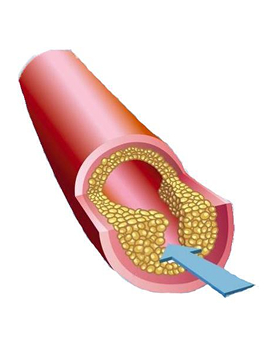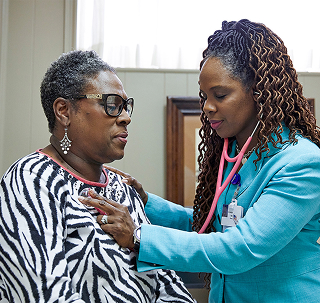Over 1 million Americans are diagnosed with heart failure each year 1

That means, almost 1 in 4 Americans are projected to get heart failure in their lifetime.2
And many don’t know anything is wrong with their hearts. Even worse, more than 20% die within the first year of diagnosis.3 So we’re on a mission to shed light on heart failure and coronary artery disease (CAD) symptoms, encourage patients to talk with their doctors, and help improve the quality of life of more Americans.
Find out if you could be at risk
Definition
What is heart failure and coronary artery disease (CAD)?
Heart failure occurs when the heart can't pump enough blood to meet the body's needs. This may be due to the heart not filling with enough blood or being too weak to pump properly. Heart failure doesn't mean the heart has stopped, but it is a serious condition requiring medical care.4 Over 6 million adults in the U.S. have heart failure.5 It can develop suddenly or gradually, affecting one or both sides of the heart. Common causes include coronary disease, high blood pressure, atrial fibrillation (AFib), and diabetes.6
CAD is a condition in which the arteries that supply blood to your heart become narrowed or blocked due to a buildup of fatty material called plaque. CAD can weaken the heart so that it can’t pump as well as it should – this is called heart failure.7
Diagnosis involves medical history, a physical exam, and various tests. Although there's no cure, treatments like lifestyle changes, medications, and certain procedures can improve quality of life.8
About 1 in 20 adults age 20 and older have CAD9
Heart conditions are affecting younger people more than ever before.10
Symptoms
Signs you may have CAD or heart failure
It’s common for people to ignore symptoms of CAD and heart failure, writing them off as signs of old age or stress. Symptoms can also be different between men and women. Here’s what to look for:
Shortness of breath
Simple activities like walking to the mailbox or climbing stairs can leave you winded. 11
Fatigue
Feeling more tired than usual can be a sign of heart disease. 11
Chest pain
Chest pain, or angina, during or after physical activity could be a sign of heart disease. 11
Symptoms for women
Women should also be on the lookout for additional symptoms
Women with CAD and heart failure may experience different symptoms, such as:
Appointment Resources
Do you have an appointment coming up with your primary care physician or cardiologist? Learn about what to talk about and which questions to ask.
Heart health questionnaire
Ask yourself these questions to determine if you may be at risk for coronary artery disease or heart failure and if you should consult with your physician.
Talk with your physician
We understand it can be scary to talk to your doctor. But being open with your doctor about how your feeling can help them diagnose and treat you. After all, you may have options that could improve your heart health and unblock the road to heart recovery.


Talk with your physician
We understand it can be scary to talk to your doctor. But being open with your doctor about how your feeling can help them diagnose and treat you. After all, you may have options that could improve your heart health and unblock the road to heart recovery.
References
1. American Heart Association. Causes and risks for heart failure. https://www.heart.org/en/health-topics/heart-failure/causes-and-risks-for-heart-failure
2. McGoon, M. D., & Benza, R. L. (2024). The worsening heart failure epidemic: Increasing prevalence and implications for healthcare resources. Journal of Cardiology and Heart Failure, 24, Article S1071-9164(24)00232-X. https://onlinejcf.com/article/S1071-9164(24)00232-X/fulltext
3. Mehta, P. R., & Fogo, A. B. (2017). Heart failure: Understanding risk and the clinical outcomes among patients. PMC - NCBI, 5336901. https://pmc.ncbi.nlm.nih.gov/articles/PMC5336901/
4. National Heart, Lung, and Blood Institute. Heart failure. https://www.nhlbi.nih.gov/health/heart-failure
5. American Heart Association. Heart failure statistics. https://www.heart.org/en/health-topics/heart-failure/causes-and-risks-for-heart-failure
6. Johns Hopkins Medicine. Heart failure: Causes and risk factors. https://www.hopkinsmedicine.org/health/conditions-and-diseases/heart-failure
7. Mayo Clinic. Coronary artery disease: Symptoms and causes. https://www.mayoclinic.org/diseases-conditions/coronary-artery-disease/symptoms-causes/syc-20350613
8. Cleveland Clinic. Coronary artery disease. https://my.clevelandclinic.org/health/diseases/16898-coronary-artery-disease
9. Centers for Disease Control and Prevention. Heart disease facts. https://www.cdc.gov/heart-disease/data-research/facts-stats/index.html
10. Harvard Medical School. Heart disease risk factors rise among young adults. https://hms.harvard.edu/news/heart-disease-risk-factors-rise-young-adults
11. Mayo Clinic. Coronary artery disease symptoms and causes. https://www.mayoclinic.org/diseases-conditions/coronary-artery-disease/symptoms-causes/syc-20350613
12. National Heart, Lung, and Blood Institute. Coronary heart disease in women. https://www.nhlbi.nih.gov/health/coronary-heart-disease/women
13. Mayo Clinic. Coronary artery disease symptoms and causes. https://www.mayoclinic.org/diseases-conditions/coronary-artery-disease/symptoms-causes/syc-20350613
 Pain in the jaw, throat or neck 12
Pain in the jaw, throat or neck 12